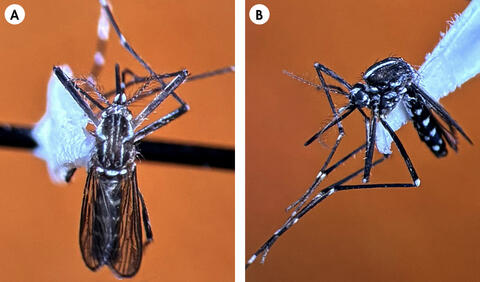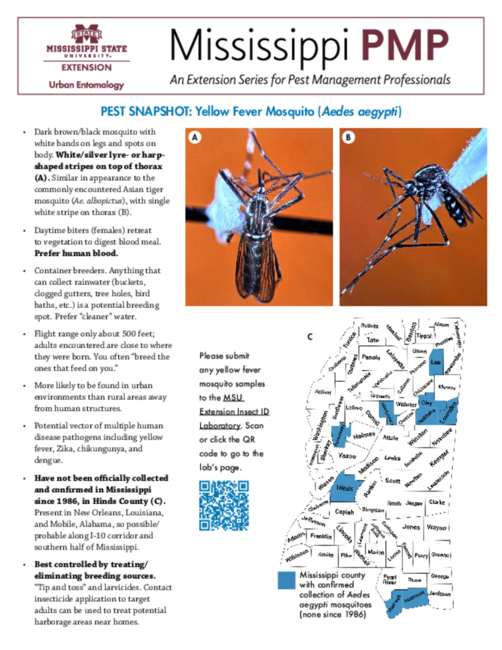P4152
Pest Snapshot: Yellow Fever Mosquito (Aedes aegypti)

- Dark brown/black mosquito with white bands on legs and spots on body. White/silver lyre- or harp-shaped stripes on top of thorax (A). Similar in appearance to the commonly encountered Asian tiger mosquito (Ae. albopictus), with single white stripe on thorax (B).
- Daytime biters (females) retreat to vegetation to digest blood meal. Prefer human blood.
- Container breeders. Anything that can collect rainwater (buckets, clogged gutters, tree holes, bird baths, etc.) is a potential breeding spot. Prefer “cleaner” water.
- Flight range only about 500 feet; adults encountered are close to where they were born. You often “breed the ones that feed on you.”
- More likely to be found in urban environments than rural areas away from human structures.
- Potential vector of multiple human disease pathogens including yellow fever, Zika, chikungunya, and dengue.
- Have not been officially collected and confirmed in Mississippi since 1986, in Hinds County (C). Present in New Orleans, Louisiana, and Mobile, Alabama, so possible/probable along I-10 corridor and southern half of Mississippi.
- Best controlled by treating/eliminating breeding sources. “Tip and toss” and larvicides. Contact insecticide application to target adults can be used to treat potential harborage areas near homes.


Please submit any yellow fever mosquito samples to the MSU Extension Insect ID Laboratory.
This work is partially supported by Crop Protection and Pest Management, Extension Implementation Program, award no. 2024-70006-43496, from the U.S. Department of Agriculture’s National Institute of Food and Agriculture. Any opinions, findings, conclusions, or recommendations expressed in this publication are those of the author(s) and should not be construed to represent any official USDA or U.S. Government determination or policy.
The information given here is for educational purposes only. References to commercial products, trade names, or suppliers are made with the understanding that no endorsement is implied and that no discrimination against other products or suppliers is intended.
Publication 4152 (POD-11-25)
By J. Santos Portugal III, PhD, BCE, Assistant Extension Professor, Urban and Public Health Entomology Program, Agricultural Science and Plant Protection, and Jerome Goddard, PhD, Extension Professor, Urban and Public Health Entomology Program, Agricultural Science and Plant Protection. Photos A and B copyright 2025 by Jerome Goddard, PhD. Map created with MapChart.net.
The Mississippi State University Extension Service is working to ensure all web content is accessible to all users. If you need assistance accessing any of our content, please email the webteam or call 662-325-2262.
